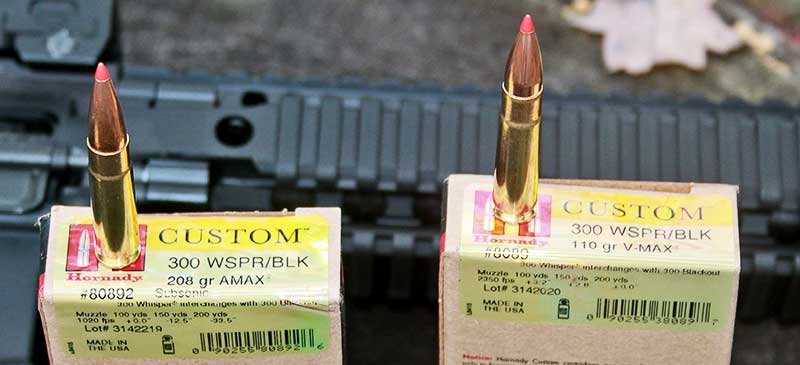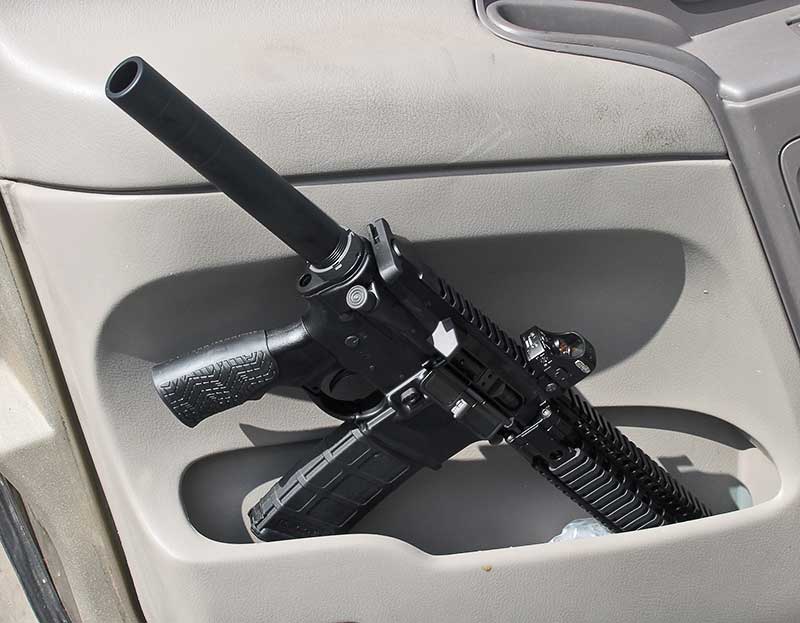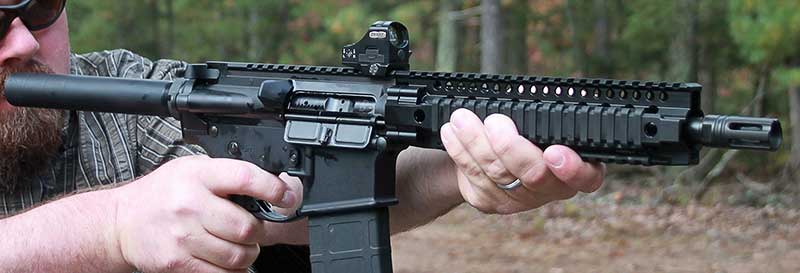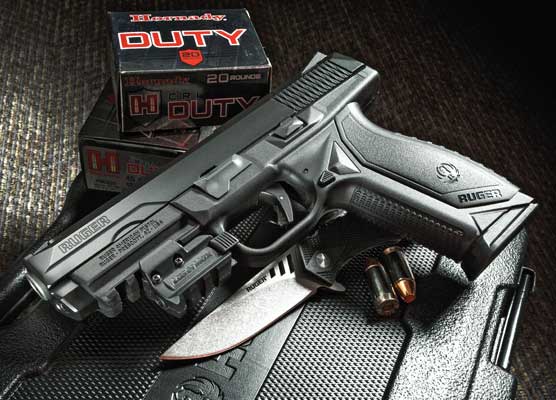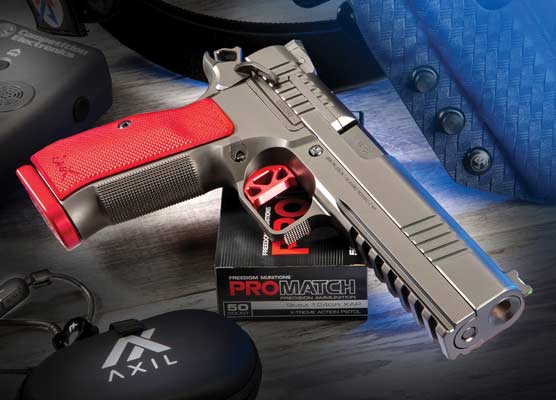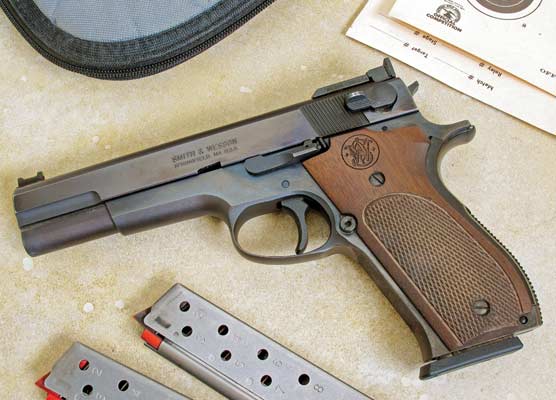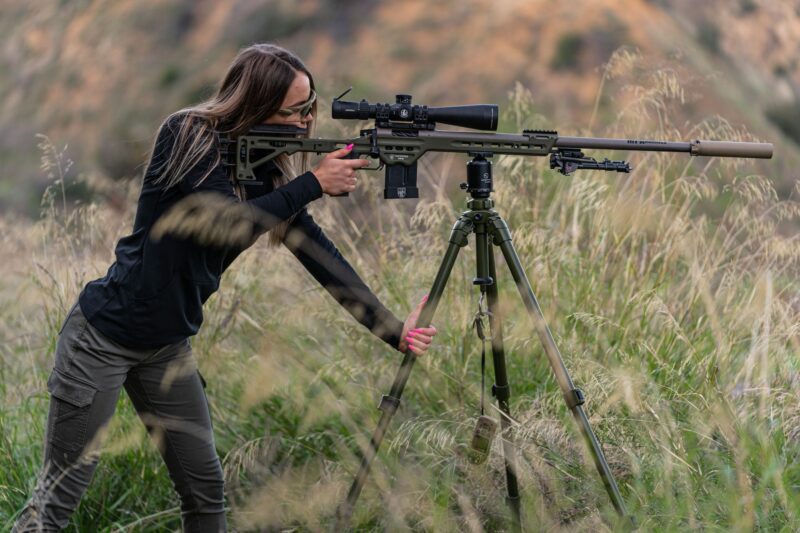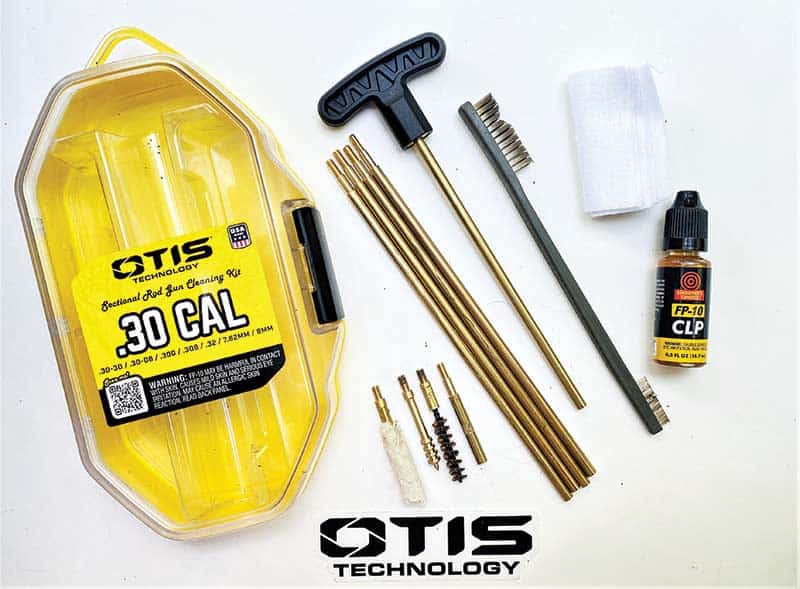Daniel Defense
.300 BLK AR Pistol
No! This Is Definetely Not Your Typical Defense Handgun
Of late, much attention seems to be on “improving” the AR platform via cartridge enhancement. Combine this with the increasing use of suppressors and the stage is set for an AR chambered in a cartridge capable of supersonic and subsonic loadings. The .300 Blackout (BLK) is emerging as one of the most successful alternate chamberings.
Reports from the war against terror have re-exposed 5.56mm poor performance in putting an adversary down quickly with minimal rounds fired. While the basic M16 design is hard to improve upon when it comes to reliability and accuracy, many lament the 5.56 caliber.
A Purpose- Driven Cartridge
Advanced Armament Corporation introduced the .300 BLK (7.62x35mm) in cooperation with Remington Defense. Their goal with the .300 BLK was to launch .30-caliber projectiles from the AR platform from existing 5.56 magazines without a reduction in magazine capacity or reliable functioning.
Another notable characteristic of the .300 BLK is its compatibility with the AR standard bolt — so only a barrel change is necessary. For comparison, a standard velocity .300 BLK 115-125 grain ammunition matches the ballistics of the 7.62×39 AK and eclipses 5.56mm both in ballistics and terminal punch. At 300 meters, the .300 BLK has approximately 17 percent more energy than the 7.62×39. The .300 BLK from a 9″ barrel has the same energy at the muzzle as a 14.5″ barrel 5.56mm M4 and surpasses it as ranges extend.
One interesting twist with the .300 BLK, obvious considering AAC is in the suppressor business, is the ability to choose subsonic cartridges for optimal use with a sound suppressor. The ability to access either supersonic or subsonic factory ammunition offers great flexibility.
Perfect Combination
Combining the .300 BLK AR with the ever-popular AR pistol was the next logical step. AR-type pistols feature shorter than 16″ barrels. Since they have no stock — in compliance with BATF regulations — only a buffer tube protrudes from the rear of the receiver.
For individuals with no legal access to an NFA Class 3 Short Barrel Rifle (SBR), the AR pistol may well be the closest way of achieving such firepower in such a compact package. Along these same lines, the increasing number of states issuing concealed carry permits (and honoring other states’ permits) is another reason why AR pistols are growing in popularity.
The Daniel Defense DD M4 300, chambered in .300 BLK, is the best of its breed. It has 1:8 10″ cold hammer-forged, chrome-moly vanadium steel barrel with a pinned, low-profile gas block. The Daniel Defense AR pistol operates via a pistol-length, direct impingement gas system. The 300 weighs just over 5 lbs. with a Daniel Defense DDM4 9″ fore-end rail made from Type III hard-coat anodized aluminum and measuring 27″ long. Daniel Defense uses their own pistol grip and the M4-style upper and lower are made from
7075-T6 aluminum.
Why A Pistol?
For many, an AR pistol, while enticing due to firepower potential, lacks much in terms of accuracy past normal handgun ranges with the added negative of weighing over 6 lbs. While definitely categorized as a fun firearm, the AR in its pistol form is somewhat limited in its effectiveness when compared to a rifle formatted AR.
A weapon like the DD M4 300 pistol has its own advantages in terms of handling, ease of concealability and increased portability. This is why handguns are the prevalent choice of weapon carried. This is not because handguns are the most effective choice — just the easiest to have around at all times in most social settings.
Carrying, Shooting
One way of maximizing the AR pistol’s capabilities is as an “off body” pistol candidate thanks to its relative compactness and potential firepower. Here the DD M4 300’s pistol designation is important for anyone with a concealed carry permit. Potential gear enhancers in this role would be the new carry bags offered by BLACKHAWK! such as Diversion Carry Board Pack and Workout Bag. Both offer “hide in plain sight” utility with enhancements to accommodate a weapon and ancillary gear. Many frown on “off body” carry, but you should decide for yourself what is acceptable in this regard.
I shot the DD M4 300 using a couple different methods. The standard two-handed hold worked OK, but the SAS-style proved to be more stable. The SAS-sling method utilizes a sling attached to the rear of the receiver forming a loop. The loop goes over your shoulder and you push the weapon forward with your strong-hand on the pistol grip and your weak-side hand on the fore-grip.
The story behind how the SAS arrived at the sling method for CQB was shooters were unable to achieve a proper cheek-weld on their H&K MP5 stocks while wearing a gas mask. The sling method faded in popularity as equipment and weapons evolved over the years, but it worked great on the DD M4 300 pistol.
In effect, the weapon is “punched out,” creating tension on the sling serving as a point of contact between you and the gun. While not optimum and not nearly as effective as a true rifle stock cheek-weld, the sling method proved better for stability and accuracy than merely attempting to hold the DD M4 300 like a conventional pistol.
Optic Choices
Daniel Defense equips the DD M4 300 with removable fixed iron sights. One immediate upgrade was the installation of a red-dot optic from Meopta. Another option would be mounting a laser designator on the fore-end rail. Both are easy to do thanks to the Daniel Defense’s M4 flattop railed receiver and railed fore-end.
The MeoSight III weighs less than two ounces and offers 1,000-hour battery life. The 3-MOA red dot simplifies aiming during quick-reaction shooting. Meopta, incidentally, produces one of the most diversified high-performing lineups of optics on the market.
For testing I used two different loads provided by Hornady — supersonic 110-grain V-Max and subsonic 208-grain A-Max. While the Hornady ammunition is listed as .300 Whisper on their webpage, a notation on the box clearly states it is usable in a .300 BLK. In fact, Hornady utilizes .300WSPR/BLK labeling on its boxes.
The .300 Whisper predates the .300 BLK and is dimensionally very similar. However, prudence dictates caution of any interchangeability unless clearly noted as with the Hornady loads. The Whisper is a J.D. Jones trademarked round dating back to 1992, In short, the .300BLK is a SAAMI standard cartridge and the .300 Whisper is not.
Higher Pistol Velocity
The two Hornady loads were chronographed giving expected results. The 110-grain averaged 2,215 fps and 208-grain delivered 1,010 fps from the 10″ barrel. Accuracy from a “bench” position with the DD M4 300 measured 1.5″ at 25 yards. Accuracy from non-supported shooting positions opened up as could be expected. A pleasant surprise was that hits were the norm out to 45-plus yards from offhand positions.
Several magazines’ worth of ammunition was spent engaging plate racks and man-sized steel targets with the DD M4 300. Drills quickly moved past stand-and-deliver drills to more dynamic drills involving movement, magazine reloads, and firing from behind cover.
The .300 BLK recoil impulse is similar to a 5.56. In an effort to determine utility of the Daniel Defense .300 BLK AR pistol a plate rack featuring multiple 6″ round targets was engaged at 15 and 25 yards combined with a TacStrike 1/4 scale steel target at 50 yards. This was an effort to establish typical field accuracy with the DD M4 300 compared to prior experiences and expectations with a more traditional handgun form.
My shooting buddies were for lack of a better word, skeptical. These doubts were based on the lack of a stock on a weapon originally designed to operate with one. These initial doubts were overcome, with the DD M4 300/Meopta MeoSights combo’s performance. The boys had a blast knocking down plates as fast as they could find the dot.
Many will argue there is no defensive/tactical value in such a non-traditional pistol as the Daniel Defense DD M4 300 — just use a full size rifle or typical handgun. However, some will be lured to the AR pistol for the intriguing possibility of maintaining handgun status with a semblance of AR performance.
The fact that the DD M4 300 AR pistol is classified legally as a handgun offers users who have a concealed carry license a certain amount of flexibility compared to a true rifle or NFA-classified weapon. We are talking about carry options based on handgun label. Here is where the AR pistol’s true asset becomes evident.
If you are considering the DD M4 300 pistol for a serious defense or tactical role, it would be best to view the AR pistol as a Personal Defense Weapon (PDW) versus a rifle. The Daniel Defense DD M4 is more potent and offers you a longer effective range than a traditional pistol if you’re trained to use it effectively and appreciate its nuances.
A Company Ethic
“If you want it done right do it yourself,” might be the unofficial motto for all Daniel Defense endeavors. Since the company started up in 2000, it has been expanding every year. It now has over 100 employees and is located in a 38,000 square foot manufacturing facility in Black Creek, Georgia with another recently opened site across the river in South Carolina. Marty Daniel decided in 2000 the AR market was ripe for someone to introduce quality aftermarket accessories such as sling adaptors, railed fore-ends, etc. (This is probably hard to fathom since today there are a plethora of AR products available. By 2009 Daniel Defense was making complete AR rifles.)
But Daniel Defense is not an AR parts assembler who then stamps their name on a weapon made from someone else’s components. In fact, they are a major supplier of OEM parts and accessories for many of the AR brands on the market.
This in-house production allows Daniel Defense a high degree of quality control and frees them up from over-reliance on suppliers. Daniel Defense makes their own barrels, upper receivers, lower receivers, receiver extensions, bolt carriers, bolts, carrier keys, gas tubes, etc. Every bolt is proofed and magnetic-particle inspected to guarantee reliable performance.
Daniel Defense even goes so far as to produce their own lower parts kits composed of the trigger assembly and a bunch of tiny parts and pins. When a company is willing to produce their own pins for their rifles, it’s a safe bet they’re obsessed with turning out a quality rifle.
For More Info
Daniel Defense
www.danieldefense.com
(866) 554-4867
Echo Valley Training Center
www.echovalleytrainingcenter.com
(540) 450-7998
Meopta U.S.A., Inc.
www.meopta.com
(800) 828-8928
Hornady Mfg, Inc
www.hornady.com
(800) 338-3220

